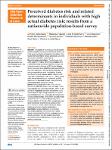Perceived diabetes risk and related determinants in individuals with high actual diabetes risk: results from a nationwide population-based survey
Heidemann, Christin
Paprott, Rebecca
Stühmann, Lena M.
Baumert, Jens
Mühlenbruch, Kristin
Hansen, Sylvia
Schiborn, Catarina
Zahn, Daniela
Gellert, Paul
Scheidt-Nave, Christa
Objective The purpose of this study was first, to examine
perceived diabetes risk compared with actual diabetes risk
in the general population and second, to investigate which
factors determine whether persons at increased actual risk
also perceive themselves at elevated risk.
Research design and methods The study comprised
adults (aged 18–97 years) without known diabetes from
a nationwide survey on diabetes-related knowledge and
information needs in Germany in 2017. Actual diabetes
risk was calculated by an established risk score estimating
the 5-year probability of developing type 2 diabetes and
was compared with perceived risk of getting diabetes
over the next 5 years (response options: 'almost no risk',
'slight risk', 'moderate risk', 'high risk'; n = 2327). Among
adults with an increased actual diabetes risk (n=639),
determinants of perceived risk were investigated using
multivariable logistic regression analysis.
Results Across groups with a 'low' (<2%), 'still low'
(2% to<5%), 'elevated' (5% to <10%), and 'high' (≥10%)
actual diabetes risk, a proportion of 89.0%, 84.5%, 79.3%,
and 78.9%, respectively, perceived their diabetes risk as
almost absent or slight. Among those with an increased
(elevated/high) actual risk, independent determinants of an
increased (moderate/high) perceived risk included younger
age (OR 0.92 (95% CI 0.88 to 0.96) per year), family
history of diabetes (2.10 (1.06–4.16)), and being informed
about an increased diabetes risk by a physician (3.27
(1.51–7.07)), but none of further diabetes risk factors,
healthcare behaviors or beliefs about diabetes.
Conclusions Across categories of actual diabetes
risk, perceived diabetes risk was low, even if actual
diabetes risk was high. For effective strategies of primary
diabetes prevention, attention should be directed to
risk communication at the population level as well as in
primary care practice.

